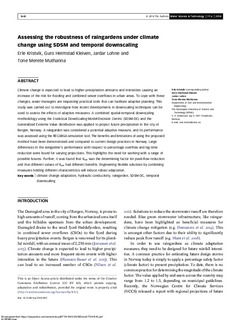| dc.contributor.author | Kristvik, Erle | |
| dc.contributor.author | Kleiven, Guro Heimstad | |
| dc.contributor.author | Lohne, Jardar | |
| dc.contributor.author | Muthanna, Tone Merete | |
| dc.date.accessioned | 2019-03-18T10:03:50Z | |
| dc.date.available | 2019-03-18T10:03:50Z | |
| dc.date.created | 2018-06-06T10:14:55Z | |
| dc.date.issued | 2018 | |
| dc.identifier.citation | Water Science and Technology. 2018, 77 (6), 1640-1650. | nb_NO |
| dc.identifier.issn | 0273-1223 | |
| dc.identifier.uri | http://hdl.handle.net/11250/2590430 | |
| dc.description.abstract | Climate change is expected to lead to higher precipitation amounts and intensities causing an increase of the risk for flooding and combined sewer overflows in urban areas. To cope with these changes, water managers are requesting practical tools that can facilitate adaptive planning. This study was carried out to investigate how recent developments in downscaling techniques can be used to assess the effects of adaptive measures. A combined spatial-temporal downscaling methodology using the Statistical DownScaling Model-Decision Centric (SDSM-DC) and the Generalized Extreme Value distribution was applied to project future precipitation in the city of Bergen, Norway. A raingarden was considered a potential adaptive measure, and its performance was assessed using the RECARGA simulation tool. The benefits and limitations of using the proposed method have been demonstrated and compared to current design practices in Norway. Large differences in the raingarden's performance with respect to percentage overflow and lag-time reduction were found for varying projections. This highlights the need for working with a range of possible futures. Further, it was found that Ksat was the determining factor for peak-flow reduction and that different values of Ksat had different benefits. Engineering flexible solutions by combining measures holding different characteristics will induce robust adaptation. | nb_NO |
| dc.language.iso | eng | nb_NO |
| dc.publisher | IWA Publishing | nb_NO |
| dc.relation.uri | http://wst.iwaponline.com/content/77/6/1640.full.pdf | |
| dc.rights | Navngivelse 4.0 Internasjonal | * |
| dc.rights.uri | http://creativecommons.org/licenses/by/4.0/deed.no | * |
| dc.title | Assessing the robustness of raingardens under climate change using SDSM and temporal downscaling | nb_NO |
| dc.type | Journal article | nb_NO |
| dc.type | Peer reviewed | nb_NO |
| dc.description.version | publishedVersion | nb_NO |
| dc.source.pagenumber | 1640-1650 | nb_NO |
| dc.source.volume | 77 | nb_NO |
| dc.source.journal | Water Science and Technology | nb_NO |
| dc.source.issue | 6 | nb_NO |
| dc.identifier.doi | 10.2166/wst.2018.043 | |
| dc.identifier.cristin | 1589339 | |
| dc.relation.project | EC/H2020/641739 | nb_NO |
| dc.description.localcode | © 2018 The Authors. This work is licensed under a Creative Commons Attribution 4.0 International License . | nb_NO |
| cristin.unitcode | 194,64,91,0 | |
| cristin.unitname | Institutt for bygg- og miljøteknikk | |
| cristin.ispublished | true | |
| cristin.fulltext | original | |
| cristin.qualitycode | 2 | |

